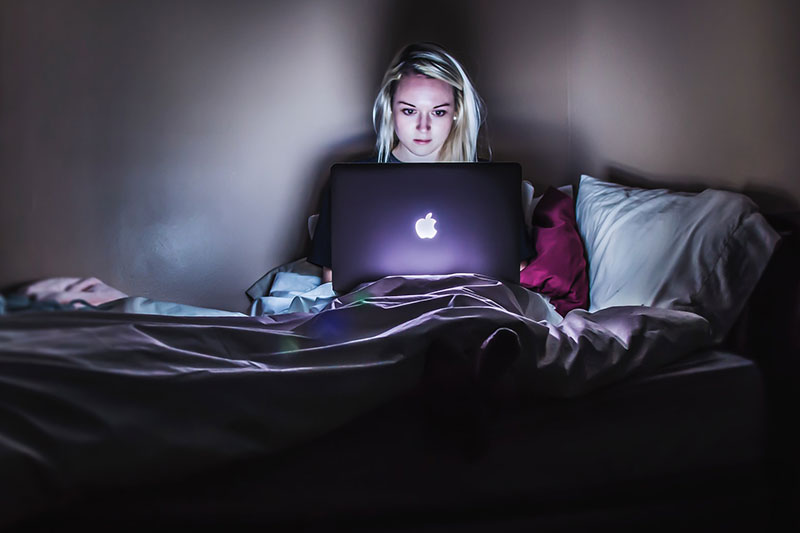As Kenosha and the rest of southeastern Wisconsin begin to emerge from a year and a half of working online, virtual learning, and isolation, many of us are thrilled about being together again. But, let’s be honest, we’re not all going to turn off our computers, throw away our phones and never look back. It certainly isn’t going to be easy to shift back to “normal” life for the millions of us who have learned to work, socialize and relax using the same 6-, 9-, or 13-inch screens.

Instead, it’s time we take a good, hard look at the time we spend online and adopt healthier tech habits. As the wise man once said, “Keep all good things in moderation.” Too much technology can be bad for sleep and pull us away from productivity; too little connection, however, can leave us feeling sad and alone.
Of course, technology is also very important for most people. They couldn’t stay in touch with friends and family, go to school, or do their job without using a device. That’s why it’s so important to set healthy boundaries for technology use — and use it as a force for good.
CMIT Solutions of SE Wisconsin has compiled seven of our favorite strategies for doing just that, now and in the future:
Set up boundaries
Screen time isn’t a bad thing. It’s OK to have a little fun looking at videos you enjoy. We use our phones and other devices for everything. But an honest assessment can help us identify how much is too much. If you’re like me, it’s easy to get distracted by getting on the runaway YouTube or TikTok video train. If so, set practical limits to reduce the time you waste and contact you have with negative or toxic content. A simple timer on your phone is very effective. Here’s an eye-opening challenge for you: Try setting a 15-minute timer on your phone next time you’re surfing. I think you’ll be amazed at how quickly the time flies by!
Implement a no-phone zone
Time away from our screens is critical. A great way to do this is to charge your phone overnight outside your bedroom. Studies show that people who use their phones right before bed or keep their phones with them sleep more poorly. This is because the blue light from screens tricks our brains into thinking it’s daytime. Also, most of what we see excites our brains and prevents us from falling asleep. If your job or family responsibilities require you to keep your phone close by, turn off all but the most important notifications overnight to avoid late-night distractions. I can personally say that this helped me a lot over the years.
Take control of your day
Instead of just finding your way through the day, what if you actively schedule out chunks of your day? If circumstances allow it, protect your day by blocking out specific chunks of time for specific tasks: an hour for doing chores, or the bills. Be sure to build in some “me time” where you can shut off distractions. I have kids. I know how hard, but important, that can be. There are many great apps for your phone to help you block your time and keep you focused.
Make sure your information is backed up, synced, and available anywhere
As we go about our lives, we are constantly adding more digital content to our lives. Pictures, songs, videos … this list goes on and on. Make sure you sync, back up, or share your files. If something does happen to your device, a reliable data backup is worth its weight in gold.
Turn family device hour into a group activity
Many families have gotten better at scheduling screen time before dinner, on weekends, or after work and school is done for the day. We’ve got a rule at our house to not look at our phones during dinner and it’s helped bring us together. If you have taken that big step, take another even bigger one by scheduling specific group activities that allow everyone to participate. This can mean looking at family photos together, funny videos, researching or planning something, or joining a multi-player video game. The point? Getting everyone’s heads out of their respective screens and creating an experience that’s healthy and communal.
Take care of your mental health
Mental health issues are no joke. They affect someone in almost every family. One of the COVID-19 pandemic’s few silver linings has been a rise in wellness apps — and a corresponding increase in the ability to address mental health challenges by seeing a licensed therapist, psychiatrist, or psychologist online. Many mental health experts say this could represent a major turning point in the industry, with expanded access for anyone with an Internet connection and the critical need to address anxiety, depression, and other mental illnesses. Do your research before committing to a particular app or booking an appointment with a clinician, but don’t let this moment pass if you are struggling.
Stay connected — with friends, family, co-workers, and like-minded strangers
Screen fatigue is real. But no one can deny the fact that Zoom, FaceTime, WhatsApp, and other video chat apps have kept our family, friends, and co-workers connected in a very difficult time. Whether you’re scheduling more video calls with friends and family, checking in more often with work, or connecting with Kenosha through online cultural events, don’t let the gradual end of the COVID-19 pandemic put an end to your expanded network of connections.














